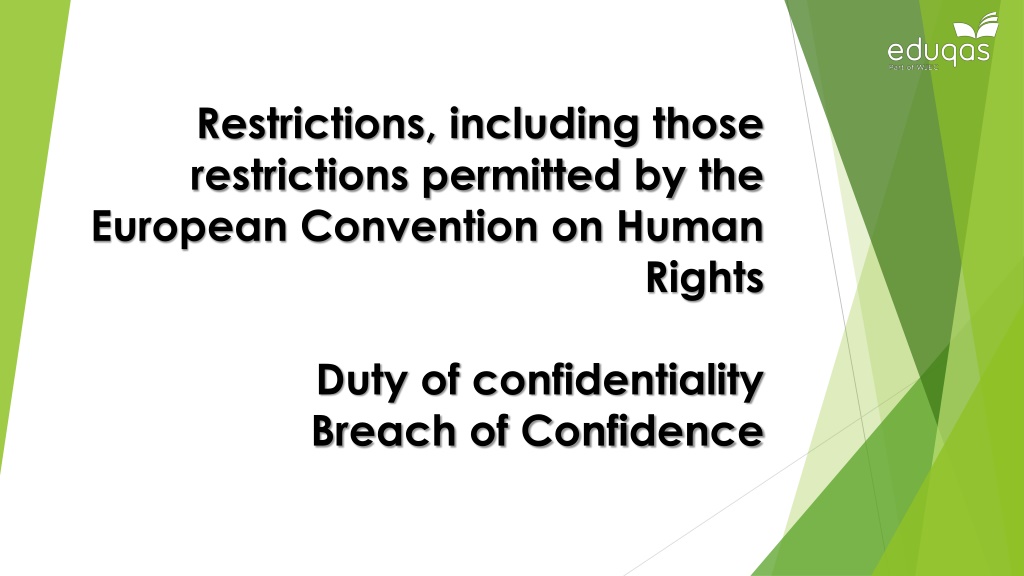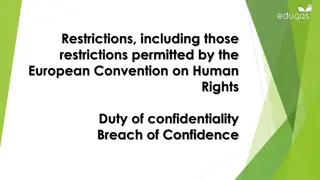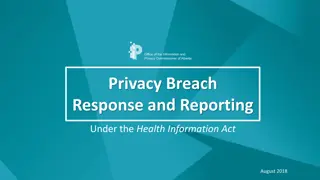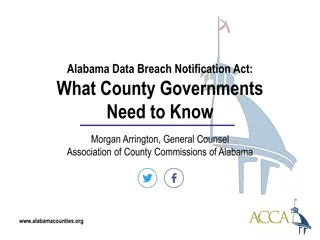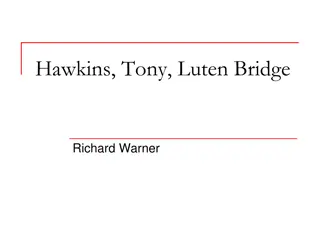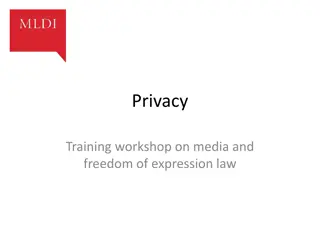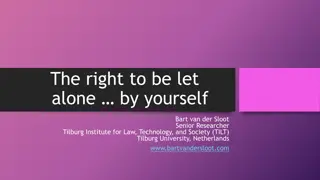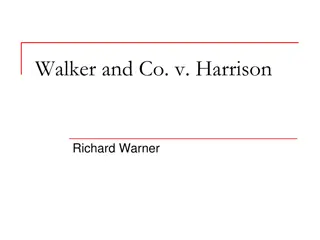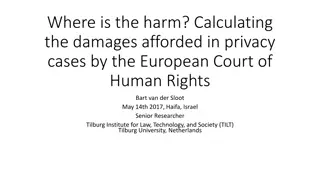Understanding Breach of Confidence and Privacy Rights in Legal Context
The legal landscape regarding breach of confidence and privacy rights, especially in the context of English law and the European Convention on Human Rights, is complex and ever-evolving. While English law traditionally does not recognize a right to privacy, recent developments and landmark cases have highlighted the importance of protecting individuals' privacy and personal information. Breach of confidence, civil remedies, and the delicate balance between freedom of expression and privacy are crucial aspects of this legal domain, shaping the rights and responsibilities in modern society.
Download Presentation

Please find below an Image/Link to download the presentation.
The content on the website is provided AS IS for your information and personal use only. It may not be sold, licensed, or shared on other websites without obtaining consent from the author. Download presentation by click this link. If you encounter any issues during the download, it is possible that the publisher has removed the file from their server.
E N D
Presentation Transcript
Restrictions, including those restrictions permitted by the European Convention on Human Rights Duty of confidentiality Breach of Confidence
Breach of Confidence Do we in English Law have a right to privacy? Lord Justice Glidewell in , Kaye v Robertson [1991] stated that: It s well-known that in English law there is no right to privacy, and accordingly there is no right of action for breach of a person s privacy .
Breach of Confidence In this country, unlike the United States, there is no over- arching, all-embracing cause of action for 'invasion of privacy': see Wainwright v Home Office [2003] However protection of various aspects of privacy is a fast developing area of the law. The recent decision of the Court of Appeal of New Zealand in Hosking v Runting (2004) is an example of this. In Britain the development of the law has been spurred by enactment of the Human Rights Act 1998.
Breach of Confidence No tort of invasion of privacy. Legal controls exist that can be used against the media and others. Competition between freedom of expression and respect for an individual's privacy. Both are vitally important rights.
Breach of Confidence What is privacy? Calcutt Committee 1990 defined it as: The right of the individual to be protected against intrusion into his personal life or affairs, or those of his family, by direct physical means or by publication of information.
Breach of Confidence What is breach of confidence? Civil remedy giving protection against the disclosure or use of information which is not generally known and which has been entrusted in circumstances imposing an obligation not to disclose it without authorisation.
Breach of Confidence The use of the civil law of breach of confidence to protect privacy can be traced back to Prince Albert v Strange (1849) Also in Argyll v Argyll (1967) where it was held that the Duchess of Argyll could obtain an injunction to prevent newspapers from revealing the secrets of her marriage, which had been disclosed to the newspaper by the Duke.
Breach of Confidence Three traditional elements of breach of confidence summarised in Coco v AN Clark (Engineers) Ltd 1969: The information must have the necessary quality of confidence about it. The information must have been given in circumstances importing an obligation of confidence. Unauthorised use of that information. 1. 2. 3.
Breach of Confidence What is information for the purposes of the law of confidence? Information concerning an individual s sexual orientation - Stephens v Avery (1988). Photographs HRH Princess of Wales v MGN Newspapers Ltd (1993). Photos from a film set Shelley Films Ltd v Rex Features Ltd (1993).
Breach of Confidence What is information for the purposes of the law of confidence? Information concerning an individual s sexual orientation Stephens v Avery (1988). Photographs HRH Princess of Wales v MGN Newspapers Ltd (1993). Photos from a film set Shelley Films Ltd v Rex Features Ltd (1993).
Breach of Confidence Since Stephens v Avery basic principle appears to be that confidentiality will be enforced if the information was received on the basis that it is confidential. Fact that information is given in confidence may be expressly communicated to the defendant as in Stephens v Avery, but can be implied from the circumstances surrounding the communication Fairnie (Dec d) and Others v Reed and Another (1994).
Breach of Confidence Fairnie (Dec d) and Others v Reed and Another (1994) Here confidential information about the format of a board game, which the claimant wished to sell was mentioned by him in passing during a conversation with a virtual stranger, the stranger was not told that it was given in confidence. Court of Appeal HELD information given in confidence due to the clear commercial value of the information.
Breach of Confidence Public interest defence Confidential information will not be protected if the public interest outweighs the interest in preserving confidentiality. AG v Guardian Newspapers Ltd (No 2) (1990) the interest in maintaining confidentiality was outweighed by the public interest in knowing the allegations in Spycatcher. Woodward v Hutchings(1977) Lion Laboratories v Evans and Express Newspapers (1985) X v Y (1988) .
Breach of Confidence and Privacy post Human Rights Act 1998 Art 8. European Convention - Right to Privacy now incorporated into the Human Rights Act 1998 - how quickly or how far judges will move the law in the direction of the protection of privacy? Individual privacy cannot be considered in isolation. Privacy must be weighed alongside freedom of speech and expression, which is also an important right under the European Convention. (Art. 10) See casespost HRA 1998: Venables & Thompson v News Group Newspapers (2001) Campbell v MGN (2004) Douglas v Hello (2007)
Breach of Confidence and Privacy post Human Rights Act 1998 See casespost HRA 1998: Venables & Thompson v News Group Newspapers (2001) Campbell v MGN (2004) & MGN v UK (2011) Douglas v Hello (2005) Re S (A Child) ( Identification :Restriction on Publication) [2004] Ash v McKennitt (2006) Associated Newspapers Ltd v Prince of Wales (2006) Murray v Express Newspapers (2008) Mosley v News Group Newspapers (2008)
Breach of Confidence and Privacy post Human Rights Act 1998 See casespost HRA 1998 Author of a Blog v Times Newspapers (2009) Napier v Pressdram Ltd (2009) BBC v Harper Collins Ltd (2010) Stig case Top Gear Hutchenson v News Group Newspapers (2011) Footballer cases: Terry v Persons Unknown (2010) Ferdinand v MGN (2011) CTB v News Group Newspapers (2011)
Setting the boundaries for privacy and the European Court of Human Rights Strasbourg cases: Von Hannover v Germany ( No 2) (2012) Springer v Germany (2012)
Breach of Confidence and Privacy post Human Rights Act 1998 Group discussion In the absence of a tort of invasion of privacy the existing laws of breach of confidence, have served many celebrities in their battles for the right to privacy (e.g. Catherine Zeta Jones). Do you think a privacy law is needed or does the law of breach of confidence suffice?
